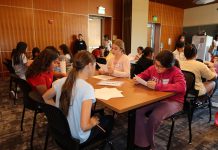Summer break just ended for youth across California. Some children savored the opportunity to participate in sports leagues, attend camps with friends or travel to new places. But for many other children, staying physically fit and academically motivated this summer was a real challenge.
During the months of summer vacation, research indicates that, on average, children fall one month behind where they left off academically in the spring. This loss in learning during the summer impacts disadvantaged children the most, accounting for as much as two-thirds of the total gap in their academic achievement compared with their more advantaged peers.
While falling behind academically during the summer, children also put on additional weight—equal to half the total weight gain acquired during the entire year.
Currently, more than 70 percent of Americans age 17 to 24 cannot serve in the military, primarily because they are too poorly educated, are overweight or have a criminal record. As a retired U.S. Air Force Brigadier General and a member of the nonprofit organization Mission: Readiness, I consider this a matter of national security.
The good news is high-quality summer learning programs in our neighborhoods successfully blend academic instruction and other enrichment opportunities for youth. Programs like Building Futures Now (BFN) offer a five-week session to help narrow the achievement gap and prepare students for school in the fall. BFN focuses on students’ potential and offers intensive methods that improve students’ math, reading and writing skills, while balancing activities that are enriching and fun.
Healthy meals and proper hydration are also key components to the program, and students are provided a selection of fresh fruits and nutritious meals to pick from daily.
There are key challenges to programs like BFN. Many lack physical space required for students to engage in the 60 minutes of moderate-to-vigorous physical activity that’s recommended on a daily basis. Further, the costs of running quality programs continue to outpace funding.
The state’s After School Education and Safety (ASES) Program supports quality after-school and summer learning across the state, serving hundreds of thousands of students each year. Hundreds of students remain on their waiting lists. Yet, since 2007 the California consumer performance index (CPI) has increased by 19 percent and the state minimum wage has increased 33 percent, while the ASES daily funding has remained at $7.50 per student per day.
Due to funding issues, a majority of programs have cut staff hours and reduced services. Each of us can do our part by urging community leaders and public officials to advocate for additional resources for quality summer learning programs.
Many school districts are already planning for next year’s programming and we must ensure that the summer of 2017 is not a season of brain drain and weight gain. Providing youth with effective ways to improve their academic skills and stay physically active during summer is just common sense, and will ensure they lead healthier, more productive lives.
Jeffrey Lawson is a retired Brigadier General, U.S. Air Force and a Morgan Hill resident.








